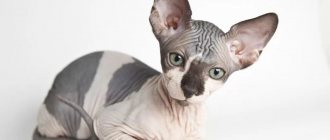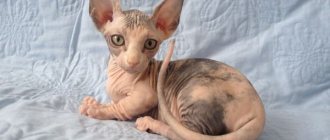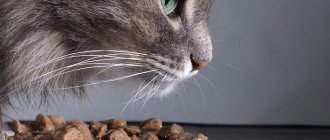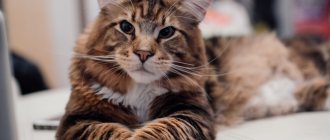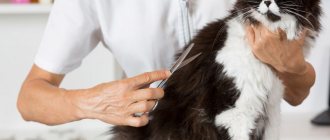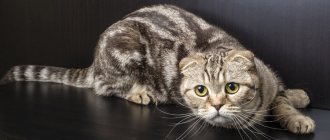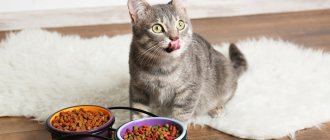For many people, their pets become not only joyful animals, but also full-fledged members of the family. To choose a suitable pet, you first need to decide on priority qualities and character traits, such as complaisance, obedience, love for children, devotion or cleanliness. The Sphynx is a very unusual breed of cat, because not everyone will like it.
What features is the unusual breed of sphinx famous for? What positive and negative characteristics does it have?
Origin story
Cats that looked like figurines were first mentioned in Ancient Egypt. The oldest breed of Sphynx was called the Mexican Hairless. Unfortunately, today it is completely lost. The last representatives were shown at the exhibition back in the thirties. Now the oldest breed - the Canadian Sphynx - is just over forty years old, the St. Petersburg Sphynx and the Don Lysak - even less.
Canadian Sphynx
In the late sixties in Canada, a hairless kitten was born to an ordinary cat. After a while, the owners crossed him with his mother and got several more hairless kittens. A few years later, the creation of the Canadian Sphynx breed was announced. Thus, the kitten named Prune became the ancestor of a new species.
Caring for my first kittens was not easy. The breeders did not yet know how to care for them, and therefore the kittens often simply died. Thanks to the fact that nine years later two more kittens appeared in Minnesota, the breed was able to improve and strengthen. However, for several years, hairless kittens continued to appear occasionally in the USA and Canada. Some of them were sent to Europe to create a new branch of sphinxes.
Interesting Facts
The Sphynx owes its appearance to the domestic cat, which gave birth to a hairless kitten in the mid-twentieth century. Later we found out that this is the result of a natural mutation and such cats are available in different parts of the world. In modern times, the Sphynx is considered a genetically strong breed with good health. The lifespan of such a pet is 14-16 years. These amazing purrs have interesting habits; they love to peer piercingly into a person’s eyes, carefully listening to human speech.
Sphynxes are characterized by specific features that need to be taken into account before purchasing such cats, so it would be a good idea to consult with a felinologist and get to know this animal personally.
Representatives of the hairless cat breed are black, while the nose, skin and paw pads have a dark gray tint. There are in nature sphinxes the color of chocolate, which varies from light to dark brown tones, unusually beautiful lilac bald representatives with a sheen of silver. In addition, there are red, white, spotted-striped and simply striped hairless cats. By nature, sphinxes are affectionate, friendly and loyal. From all family members, they choose one owner, with whom they have “intimate conversations” and allow him to caress.
Diet features
Sphynx cats love to eat, so their diet must be monitored so as not to cause obesity.
As for feeding, sphinxes love to eat because they have an increased metabolism and a wonderful appetite. You can feed them both natural products and prepared food. However, it is worth considering that hairless cats are prone to obesity, therefore, it is important to closely monitor their diet. At the first significant weight gain, you need to consult a cat nutritionist and adjust the diet. Sphynx breeders in Europe and America do not advise experimenting with natural nutrition precisely because of the increased threat of obesity.
Appearance
The breed improved over time, and the appearance of the cats gradually changed. The first representatives had folds and grooves all over their bodies. Modern Canadian sphinxes have retained them only in places. They are not as wrinkled as their ancestors and have smoother skin. Reviews and description of the Canadian Sphynx breed:
- Their body size is quite average. They cannot be called large cats, despite their strength and muscularity.
- They have a magnificent long and thin tail that is gracefully curled upward.
- The hind legs are generally longer than the front legs, giving the dog a slightly elevated figure.
- Mustaches are practically absent.
- Little kittens are born with folds all over their faces. Over time, it smooths out a little, and in adult cats, as a rule, wrinkles remain only in the neck area and on the top of the head.
- Straight and widely spaced ears are a distinctive feature of this breed. It is allowed to have a small fluff on the tips of the ears. The tips are usually rounded.
- It has a well-formed and defined muzzle with expressive eyes and a large nose.
- The shape of this cat's head is called wedge-shaped. It is quite harmonious, as it has almost the same width and length.
- The eyes are usually large and round in shape, tapering slightly towards the tips.
- The paws are slightly curved and have convex pads at the ends.
- Thanks to its long toes and pads, the Sphynx has a unique gait. Externally, it feels as if he is gracefully walking on heels.
The greatest delight is the velvety, soft skin of sphinxes. According to owners, they constantly want to touch and stroke their pet. The color of cats can be very different. The breed standard identifies several types of Sphynx colors:
- Quite popular is brindle.
- The white color with dark spots is called “harlequin”.
- There is a Siamese color, which has four varieties.
- The striped tabby looks quite original and attractive.
- An interesting color called "van" has a completely white background with a spot on the top of the head. The presence of two or three spots on the body is also allowed.
There are also solid and bicolor shades, which can be seen in the photo of the Sphynx breed. Among monochromatic cats you can find lilac, chocolate, white and cream cats. There is also a rather rare red tint, blue and black. Bicolor color assumes the presence of any of the listed shades in combination with white.
Caring for these animals requires effort and attention from the owners. There are some features of Sphynxes that are unique to this breed. It should be borne in mind that these cats are practically not independent and are very attached to their owner.
Description of the breed
A distinctive feature of the breed is hairlessness, but it is not the only one.
Sphynx standard
A purebred Sphynx must meet the following standards:
- Body: warm and soft to the touch, like a soft peach. Average build with unexpectedly high weight; the belly is rounded. Sphinxes are characterized by sexual dimorphism, i.e. The difference between females and males is in size and weight - females are much smaller than males. Thus, the weight of a male reaches 5 kg, of a female – up to 3.5 kg.
- Limbs: proportional, muscular. The hind legs are longer than the front legs. The front legs are set wide due to the large chest (“bulldog” style). The pads of the toes are thick and make the paw look like a baby's fist.
- Head: the shape resembles a modified wedge, the length of the head is slightly greater than the width, pronounced cheekbones. The skull is rounded, the nose is straight with a pronounced “hollow” where the forehead meets the nose.
- Eyes: large, round, lemon-shaped (wide in the middle and tapering towards the edges); the distance between the eyes is slightly larger than the size of the eye. Any eye color.
- Ears: very large, open, erect. Set wide apart, without brushes.
- Wool: a small light fluff on the skin is possible - the skin of a sphinx is often compared to the skin of a child; a tuft of hair at the tip of the tail is also acceptable. The length of hair on the body is divided into the following types:
- naked (homozygous) - hair and whiskers are completely absent, the body is covered with numerous folds of skin. Rarely born. Cats feel rubbery and sticky to the touch. It is difficult to stroke such a sphinx, so it is as if they are gently pinching the skin.
- flock - thin microhairs up to 0.1 cm; as sphinxes grow older, they can undress and become naked. The flock feels like velvet to the touch; such a cat can be stroked with your hand without difficulty.
- velor - wool 0.2 - 0.4 cm long. Wool may not be present on all parts of the body.
- brush (velor) - hair length up to 0.5 cm. The coat is straight or curled, like a Rex, and feels hard to the touch.
Hollowborn
Flock
Velours
Brush
Colors
The color of sphinxes without hair is determined by pigmentation on the skin. The color of the naked-born Sphynx appears 2-3 hours after birth.
Types of colors of Canadian Sphynxes:
- Solid: the predominance of one color in pigmentation. The nose is combined with the color, the paw pads are either the color of the pigmentation or a pinkish tint. Possible colors:
- white;
- cream;
- lilac;
- blue;
- faun;
- cinnamon;
- red (red);
- chocolate;
- black.
- Tortoiseshell (totrie): Characteristic only for females. It is rarely found in cats and is regarded as a deviation - such males are most often infertile. Pigmentation consists of two colors: in the classic version – black and red; in clarified - blue and cream. Proportions and variations may vary. Possible options:
- blue turtle;
- black;
- lilac;
- chocolate cake;
- tortoiseshell cinnamon;
- tortoiseshell faun.
- Tabby color (tabby): dark spots on the back, tail and limbs. The nose and paw pads are either pigmented or pinkish in color (typical of light colors). Tabby color types:
- spotted – pigmentation in the form of spots;
- marbled - spots on the body in the form of patterns similar to stripes on marble;
- tiger/mackerel – spots in the form of horizontal stripes.
- Bicolor: primary color (solid, tortoiseshell, tabby) combined with white. The painted part has clear boundaries from white. One ear should be painted. The nose and paw pads match the base color.
- Color-point: The color characteristic of Siamese cats is a light body with darker tips of the ears, nose, paws and tail. Characteristic eye color is sky blue. The paw pads and nose match the color of the point. Depending on the “darkened” color, color options can be:
- seal point;
- chocolate point;
- blue point;
- lilac point;
- cream point.
How and what to feed the Sphynx
There are a lot of rumors and prejudices around this breed. For example, many believe that Sphynx cats are extremely picky eaters and are disdainful of eating food that has been sitting for two to three hours after cooking. This statement is completely wrong.
First of all, cats of this breed are big gluttons, since they have to spend a lot of energy to maintain heat. They eat much more and more often than others. Experts advise purchasing high-quality food for them, designed specifically for this breed.
Approximate diet
They are contraindicated in eating fatty, salty and smoked foods. Any of these products can cause a sticky brown residue to appear on your skin. As a rule, the daily diet consists of three types of food: natural, dry food and wet canned food. Owners are advised to place three bowls at the same time into which each of these feeds is added. Natural products must be raw (meaning meat) or cooked. So, what should you feed the sphinx?
- The majority of your daily diet should be beef or chicken. Animal liver is also allowed.
- About fifteen percent are dairy products. They should not be sweet or too fatty. Preference is given to fermented baked milk, cottage cheese and special milk intended for animals.
- Dry food is selected only from well-known companies specializing in cat nutrition.
- The animal is given a chicken egg no more than once a week.
- It is recommended to use porridge or vegetable mixtures. Their quantity should not exceed five percent of the total food volume.
Thus, we can summarize: 60% - meat, 20% - dry food, 15% - dairy products, 4% cereals and vegetables and 1% seafood.
Care
Of course, caring for a pet will be different from caring for a cat with a wool coat. However, it is not as difficult as it might seem at first glance - the main thing is to follow the basic rules.
Wool
Increased body temperature also affects the animal's sweating - sphinxes sweat a lot. Sweat has a rather specific smell, so caring for your pet's skin should be regular - bathe it once a week and wipe it with a damp cloth as needed. If you neglect skin care, a gray coating forms on it - a mixture of dirt, sweat and sebum.
Reference! It is better to take wipes and shampoo that are hypoallergenic and fragrance-free. You can choose children's ones so as not to provoke irritation on your pet's delicate skin.
You should bathe only in warm water, after which you must wrap it in a terry towel, otherwise the baby may freeze and catch a cold.
Nutrition
Due to their elevated body temperature, Sphynx cats have an accelerated metabolism. Therefore, they need to eat more than representatives of other breeds. The Sphynx should be fed no more than twice a day, preferably at the same time.
Important! Obesity is a common disease among Sphynx cats. You should not feed your pet every time he asks.
There are two main nutritional concepts, from which each owner chooses the most suitable:
- Natural food (meat, sea fish, dairy products). In this case, you need to add vitamins to your diet. Also try to minimize the amount of fatty foods, as they are harmful to your pet. Meat should be given only in the form of pieces, and not minced meat, which will ensure the cat has healthy teeth.
- Ready food . If you prefer ready-made food, pay attention to its quality. To ensure a balanced diet, you should purchase super-premium food and higher.
Important! Remember, extensive advertising of a product is not at all a sign of quality - first of all, pay attention to the composition of the food.
When choosing any food concept, do not forget that your pet should always have a bowl of clean and fresh water.
Caring for ears, eyes, claws
Sphynx cats, like other cats, can accumulate dirt between their claws and in their ears, which cats of other breeds cover with a fluffy coat.
- Ears . The secretion accumulated in a pet's ears does not pose a danger and does not interfere with hearing, but outwardly it does not look aesthetically pleasing. You should clean your pet’s ears like a small child – with a cotton swab (not a swab), carefully and slowly.
- Claws . In addition to regularly cleaning the dirt between the claws, it is worth paying attention to the claws themselves - trimming them will help the owner keep the furniture in its original form.
- Eyes . It is also necessary to monitor the condition of the eyes to avoid various infections. You can wipe your pet's eyes with green tea or chamomile decoction using a cotton swab.
Walking your pet
Some experts agree that the Sphynx is exclusively a domestic animal. However, to provide your cat with physical activity, it is possible and even beneficial to take him for a walk, but no more than 1-2 times a week.
Important! You can only take your pet for a walk in warm, dry weather.
Sphynxes love to soak up the sun. Tanning (yes, hairless cats can tan too!) causes their thin skin to slightly change pigment - bronze shades appear, as well as freckles and spots.
Important! Do not leave your pet under the scorching rays of the sun - severe burns may occur on its delicate skin.
In general, it is enough for a cat to install a high scratching post and buy several toys. Sphinxes especially love pointers with feathers tied to them and running mice running on batteries.
Useful video:
How to care for your skin
Owners of Sphynx cats often note in their reviews that after a while a brown coating appears on the surface of their pets’ skin. This is a feature of the structure of the skin. Sphynx cats should be bathed (or at least wiped with a napkin on their sides) at least once every fourteen days. In specialized stores you can buy shampoos designed specifically for sphinxes. As a rule, other detergents are not suitable for them. The seller can also offer cat care wipes. Fortunately, hairless pets love to bathe. Water treatments are easy and relaxed.
If you do not maintain hygiene, then over time various dermatological problems may arise, which will be quite difficult to get rid of.
Another feature of the Sphynx's skin is that it can tan. This can be seen in those cats that love to bask in direct sunlight. By the way, such procedures do not bring anything good for them. Being in the sun for a long time, a sphinx can easily get sunburned.
Diseases and hygiene
Sometimes your cat has bad breath. This is primarily due to inflammation of the gums, which can be damaged by spicy foods (for example, shrimp). And also in the absence of oral hygiene when keeping sphinxes, the teeth of animals quite often deteriorate. They become covered with a yellow coating and become loose over time. You can purchase a special toothpaste for cleaning your teeth at your veterinary pharmacy. It is also recommended to feed the cat cleansing food for some time.
According to reviews of Sphynx cats, they are most often exposed to colds. This is a real scourge. A Sphynx cat should not be in a draft after bathing. Among hereditary diseases, the most commonly observed are airway obstruction, congenital disorders of muscle tone, and heart disease.
The skin and ears of the animal require special attention. A brown, sticky coating may form on the skin, and dirt may accumulate in the ears, leading to inflammation. Due to the lack of eyelashes, the Sphynx sometimes has eye problems. The owners will have to take full responsibility for caring for these parts of the body.
Cats have sebaceous glands under their tail that secrete oil. Sometimes the glands become blocked and then acne occurs. The owners must carefully remove them, and then wipe the tail with a special means for degreasing the skin.
Conclusion about the breed
Adult Sphynx cats rarely get sick. In case of infection, they recover fairly quickly, maintaining immunity to the disease for life. This is due to increased body temperature. Kittens and young animals are more susceptible to infections, especially respiratory diseases. Therefore, when keeping Sphynxes, their vaccination is mandatory. Sphynx cats tolerate it well at any age.
For kittens, it is better to use an inactivated vaccine, at least in the first stages of vaccination, since a live vaccine can sometimes cause complications, since the virus present in the vaccine is still alive, although modified and weakened. Adult animals tolerate vaccination with live vaccine easily and, as a rule, without complications.
Puberty occurs in sphinxes at the same time as in other cat breeds, i.e. about a year. The final formation of the animal occurs by the age of one and a half years. The first heat in cats occurs from 5 to 12 months, depending on heredity.
Males reach sexual maturity by about a year, and about half of them mark. The number of kittens in a litter varies: from 2 to 5, but more often 3-4 kittens. Sphynxes give birth normally, with no tendency towards pathology. Kittens are born naked, all folded and look like fledgling chicks.
The less fur a kitten has, the nakeder it will be in the future. The eyes open very early, on the 3-4th day. Kittens' ears hang down like those of puppies and rise up around the 3rd week, and the larger the Sphynx's ears, the more they hang down and later rise. Kittens are very active and they develop intellectually earlier than physically.
As with all breeds, the period of weaning from the mother and the transition to independent feeding is difficult. It is necessary to monitor the condition of the kittens and take urgent measures at the first signs of diarrhea, since Sphynx cats lose their vitality faster due to their increased metabolism. It is also necessary to protect kittens from sources of possible respiratory infections. [wp-review id=”8345"]
Reviews of the Canadian Sphynx breed
The appearance of small sphinxes is simply unique, it is impossible not to fall in love with them. They look like Cheburashka and a dinosaur at the same time. Very long-eared, naked, all folded, including paws and tail, they rush around the room, stomping loudly, like a herd of hedgehogs, pressing their ears to their backs.
And if they fall, there is a loud slap, as if a wallet had been thrown on the table. Their character and behavior are like those of mischievous children. Of course, they do not consider themselves cats. They are intelligent, easy to train, human-oriented, and get along well with any breed of cats and dogs and other domestic animals.
Character traits
They are extremely attached to their owners and practically cannot do without a person. They may have conflicts with other animals. It has been noticed that sphinxes do not particularly like communicating with cats and cats, both their own breed and those of others. Owners sometimes get the impression that sphinxes consider themselves not cats, but people. For them, procedures that ordinary cats cannot tolerate are often considered normal. For example, they love to swim and are patient and calm about cutting their nails and caring for their ears. They are also quite convenient to treat.
Of all other breeds, Sphynxes are perhaps more inclined than others to eat human food. This doesn't mean it's good for them. It’s just that such close communication with people makes itself felt and the animal gradually takes over the human habits. For example, not every feline will eat, like the Sphynx, sauerkraut, fresh tomatoes, raw potatoes, fresh peas, and so on.
Character
One thing can definitely be said about this breed: they love everyone! They love to cuddle with their owners, play with children with pleasure, happily greet guests and get along well with other animals. Sphinxes love human warmth and affection, they constantly huddle close to people, always purr contentedly and are almost never capricious.
They cope well with trips, visits or moving - they do not experience stress on these occasions, like many other breeds.
They are smart and immediately understand where to sharpen their claws and where to go to the toilet. But they do not like to be alone and suffer greatly when alone.
Also, Canadian hairless sphinxes have such a quality as fidelity. They are extremely loyal to their owner, whom they consider their best friend. If the owner is sad, the pet feels it and will entertain him for hours until he cheers him up. Sphynxes love to sit on their arms and lie on their heads - these are their favorite places. And if for most other breeds it is important to simply have a home, then these cute hairless creatures need a person to be nearby all the time. And they happily give him all their love, faithfully and unobtrusively always being there.
Nail care
To trim nails you will need to purchase a special device. Owners should carefully carry out the procedure, trying not to touch the pink edging, otherwise the cat will feel pain. A thin red vessel can be easily noticed and carefully walked around it. If blood does appear, the claws should be wiped with hydrogen peroxide. As a rule, only the tip of the nail is trimmed, leaving most of it. Sometimes cats bite off their claws themselves. Sphinxes also have this tendency.
Many owners also purchase scratching posts. They can be either horizontal or vertical. This item is selected depending on the animal’s habits. Not only kids, but also adults quickly get used to scratching posts.
How to breed
Usually the female gives birth very easily and quite quickly. Sphynx kittens are born without difficulty. It is recommended to help the cat get rid of the placenta, as well as wipe newborn kittens and keep them warm until the mother finishes giving birth. Sometimes the number of kittens can reach twelve. In reviews of Sphynx cats, the owners of these cats say that they open their eyes quite early and are characterized by increased activity. In kittens, you can notice a light fluff on the top of the head, which goes away after two to three months. They are more wrinkled than their parents. As they grow, the folds smooth out and remain only in the head area.
The onset of pregnancy is usually difficult to miss. The cat becomes even more affectionate and affectionate towards its owner. Closer to childbirth, the female prefers to retire. After about sixty-three days, the long-awaited birth occurs.
Mating
The owner of the male must accept the cat on his territory. First of all, he provides her with peace of mind and comfortable living conditions. Sometimes owners have to help their pets. The mating process itself lasts no more than two minutes. The fact that it has passed can be determined by the behavior of the animals. The female prefers to lie on her back and roll on the floor for a while, and the cat immediately starts licking her body.
Judging by the reviews about the Sphinx, the owners prepare for this process in advance. If the owner has decided to breed kittens, then it is highly not recommended to give the cat hormonal drugs to suppress desire. After he is convinced that everything is fine with the animal, he can look for a partner. Before meeting, the animals undergo a process of expelling worms and other parasites so that they do not infect each other. Cats also have their claws trimmed. The only thing you should not do before mating is bathe your pets, so as not to remove the specific cat aroma released by secretions.
Features of the species
There are three types of sphinxes: Canadian, Don and St. Petersburg. Each of them has its own characteristics. For example, the St. Petersburg Sphynx has long limbs and a strong body. He has fairly wide cheekbones on a wedge-shaped head. The chin of these cats is also quite powerful. A distinctive feature of the St. Petersburg Sphynx is its almond-shaped eyes. The Canadian ones are round. Eye color is usually blue or green. The nose of this breed is quite large. Together with slanted eyes, it is a rather original animal in appearance, which is liked by many owners. Another distinctive feature of this breed is its pointed ears.
The Don Sphynx has a fairly large size and a muscular body. He also has almond-shaped eyes and well-defined cheekbones. The forelimbs of the representative of the Don breed are quite long, and their size is almost the same as the hind limbs. The ears are large and rounded at the ends.
Canadian Sphynxes have fairly large body muscles with short stature. He has large, expressive eyes that occupy most of his muzzle. The head is also wedge-shaped and whiskers are almost completely absent. A distinctive feature is the long hind limbs, as well as very large and wide ears.
In addition, almost all three types of sphinxes presented differ from each other in skin. For example, in Donskoy it is quite elastic and has wrinkles only under the arms and on the top of the head. The St. Petersburg Sphynx has rough and elastic skin. Unlike other types, it is quite redundant. The Canadian Sphynx has the most pleasant skin. Cats of this breed are covered with velor, velvety down, which is very pleasant to the touch.
basic information
Sphynxes are cats of a hairless breed, which have several varieties, depending on the place of origin of the breed, that is, Canadian, Don, Ukrainian Levkoy, Peterbald.
The Canadian Sphynx is distinguished by the fact that it has short hair on its paws, muzzle and tail, and has practically no whiskers. Weight varies from 3 to 6 kg. The first representative was discovered in 1966.
Canadian Sphynx
The Don breed should have no hair at all, only pleasant, soft and warm skin to the touch. In 1986, a resident of Rostov-on-Don found a kitten on the street that was so frightened that its fur was coming out in clumps and did not grow back. The breeders wanted to consolidate this feature and thus the Don Sphynx breed was born.
Don Sphynx
The Ukrainian Levkoy has an interesting characteristic difference - folded ears, like a Scottish fold cat, and lack of hair, like the Don Sphynx. The first representative of this unusual breed was bred by felinologist Elena Biryukova in 2004 on January 21.
Ukrainian Levkoy
Peterbald breed was created in 1996 by crossing the Don Sphynx and an Oriental cat. St. Petersburg is considered its deposit. Ears spread out to the sides are characteristic.
Peterbald
